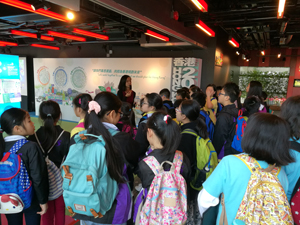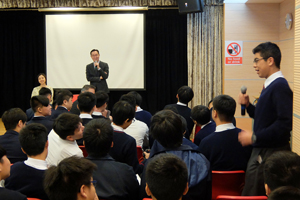“Hong Kong 2030+”: professional and evidence-based strategic planning
|
Long-term and forward-looking urban strategic planning has played a vital role in Hong Kong’s urban development in the past half the century or so. Amid the various global and local challenges, the Development Bureau and the Planning Department commenced the study titled “Hong Kong 2030+: Towards a Planning Vision and Strategy Transcending 2030” (“Hong Kong 2030+”) in 2015 to update the territorial development strategy for Hong Kong. We launched a six-month public engagement (PE) exercise in October 2016 to share with the public our strategic planning concepts, including the three building blocks (i.e. planning for a liveable high-density city, embracing new economic challenges and opportunities, and creating capacity for sustainable growth); a conceptual spatial framework encompassing a metropolitan business core, two strategic growth areas, three primary development axes and a supporting transport network. “Hong Kong 2030+” helps explore our strategies and feasible options for the overall spatial planning, land and infrastructure development beyond 2030. Today (30 April) is the last day of the PE exercise. I would like to express my sincere appreciation to members of the public for their enthusiastic participation in and insightful suggestions on “Hong Kong 2030+”. Together, we will help shape our home beyond 2030. In the past six months, we organised and took part in about 250 PE activities of different forms and scales to tap the views of stakeholders through various channels. Among others, we held three major public forums, eight topical discussion sessions and knowledge-sharing seminars, as well as 140 briefings and guided visits. We consulted members of the Legislative Council, 18 District Councils, and more than 160 committees, statutory bodies, public institutions, chambers of commerce, non-governmental organisations, environmental groups, political parties, think tanks, professional bodies, community groups, concern groups, schools, the media, and more... At the same time, we took part in forums and sharing sessions organised by different bodies. In sum, we managed to reach out to more than 10 000 people. We attach great importance to these engagement opportunities, and note the public eagerness and aspirations for a better future. Extensive engagement The “Hong Kong 2030+” PE exercise is both rich in content and details. We have condensed the wealth of study materials into a PE booklet of 82 pages, and have uploaded 15 topical papers and reports onto the “Hong Kong 2030+” website, covering an array of strategic planning topics including the global and regional development trends; baseline review on population, housing, economy and spatial development pattern; urban design and green and blue space conceptual framework; agriculture and planning for recreational and community farming; building of an inclusive and supportive city; land use requirements and supply analysis; land supply considerations and approach; transport infrastructure and traffic review; baseline review for infrastructure provision; environmental protection and nature conservation for sustainable growth; a smart, green and resilient city strategy; and a conceptual spatial framework. All these total up to more than 700 pages. In order to present such an abundance of information in a user-friendly way, we have prepared publications, a dedicated website, topical reports, roving exhibitions, posters, radio and TV announcements in the public interest to raise public awareness of “Hong Kong 2030+”. More than 50 000 copies of information booklets and pamphlets have been distributed, and about 20 000 visits to the thematic exhibition at the City Gallery in Central have been recorded. These figures are testimony of all those Hong Kong people who care about “Hong Kong 2030+”. Their views will be carefully considered in the course of our study. Voices of the young people With a time horizon encompassing the next 20 to 30 years, Hong Kong’s territorial development strategy is a strategic plan that transcends generations and goes beyond several terms of government. Our planning work must keep abreast of time and learn from previous experiences. Regular updates are necessary, and we will work with professionalism and an evidence-based mindset along the way to promote long-term development of the city and the well-being of all, rather than focusing on short-term considerations. The secondary school students and undergraduates today in particular will be the cornerstones of our society in 2030. We hence organised or took part in more than 30 events targeted at youngsters to establish direct dialogue with them. Apart from the Workshop for Young Professionals held in November 2016, I also visited two secondary schools recently to have candid exchange with students. Participants were well-prepared and raised many mind-provoking suggestions and viewpoints on a number of issues such as the natural environment, water resources, brownfield development and housing-related supporting facilities. These demonstrate in every way the commitment and passion of our younger generations for the society they belong to. Independent view analysis Hong Kong is a diversified society, with wide-ranging views on the long-term land use planning and development. I note that many Hong Kong people share the view that the “double ageing” problem, i.e. our ageing population and building stock as raised in the “Hong Kong 2030+”, needs to be properly addressed. People hope to see concrete measures to enhance liveability and our living space. Many also expect the Government to improve the living environment by tackling more pressing problems such as admission to public housing, home purchase and high rental cost. Some are especially concerned about how Hong Kong can create development opportunities for different industries and nurture and attract talents through spatial planning measures. Some people support optimising the use of our precious land resources and creating capacity to cope with challenges and needs in the future; while some show concern, worry or even doubt about the need, site choice, scale and development approach of the planning for land development, large-scale infrastructure projects and the strategic growth areas. So far, we have received more than 4 000 written submissions in different forms from members of the public, representatives, students, academics, professionals, commercial or industrial associations, district organisations, development and environment concern groups, and more. We will conduct detailed analysis of all the views received, records of PE activities and related media materials, and an academic research institution has been commissioned to compile an independent analysis report. Meanwhile, we are conducting or will soon commence the preliminary technical assessments including the Transport and Land Use Assessment - Feasibility Study, Strategic Environmental Assessment and Sustainability Assessment in order to facilitate the formulation of an appropriate spatial framework, development strategies and overall planning direction. Through these assessments, we will be able to evaluate the potential social, economic and financial impacts to be brought about by the long-term planning. The updated territorial development strategy will be finalised after taking into account the relevant assessment results and public opinions. The whole “Hong Kong 2030+” study is targeted for completion in 2018. Forging consensus with collective wisdom The PE exercise for “Hong Kong 2030+”, which is coming to an end, has formed a basis of, and will be a starting point for, our long-term strategic planning for the next generation. Recognising the many topics and issues relating to the territorial development strategy, we have done our best to provide information needed for rational discussion. With primarily broad direction involved in strategic planning, the interactive engagement process is aimed mainly to pool collective wisdom of different sectors of the community, professionals, as well as members of the public on planning issues. While we have no crystal ball that can accurately predict the future and gaze the results of our strategic planning, as 2030 is just ten-odd years away from now, we must spare no time to put words into actions and plan for sufficient land and space for our future human, economic and social activities. Strategic planning is about mapping out a framework for the unpredictable future and generating options for the development of land, space and infrastructure, with a view to embracing opportunities and challenges that may arise. It will not be easy to meet or to strike a balance between aspirations of all kinds during the course of planning; carrying out detailed planning for individual development proposals in a timely manner could likewise be a challenge. Yet, problems are to be overcome, and we have to accept trade-offs and make difficult choices. In the spirit of mutual understanding and striving for a common ground, we will all rise to the challenges together, under a visionary, proactive, pragmatic and action-oriented approach, in order to cater for our future generations with an appropriate and robust development strategy. With these in mind and in action, we will be able to enhance the quality of life in Hong Kong, and realise the vision for a “liveable, competitive and sustainable” metropolitan of high density and efficiency.
The Conceptual Spatial Framework proposed in “Hong Kong 2030+”: |
|
30 April, 2017
Back
